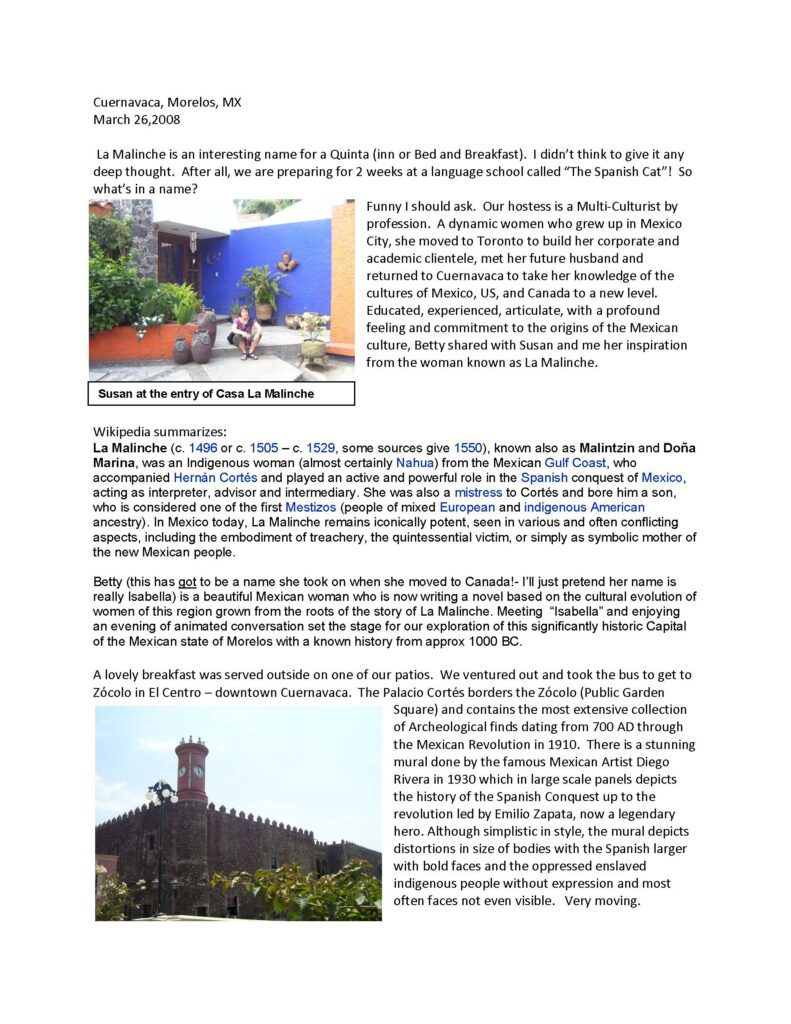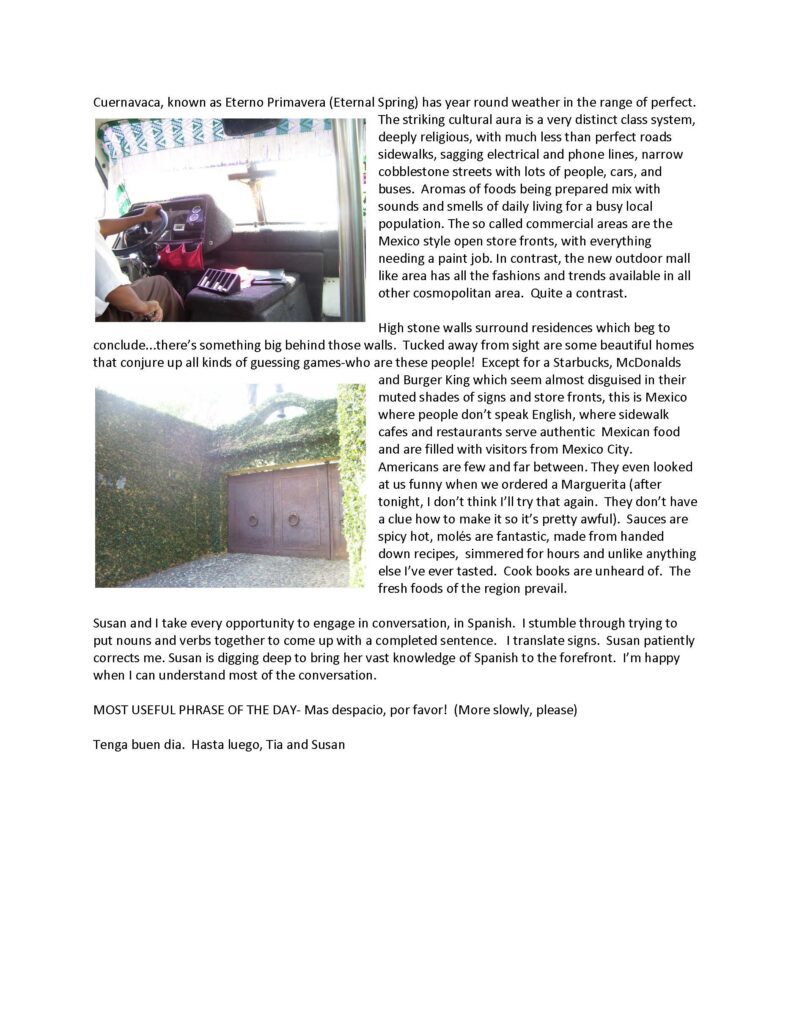Cuernavaca, Morelos, MX
March 26,2008
La Malinche is an interesting name for a Quinta (inn or Bed and Breakfast). I didn’t think to give it any deep thought. After all, we are preparing for 2 weeks at a language school called “The Spanish Cat”! So what’s in a name?
Funny I should ask. Our hostess is a Multi‐Culturist by profession. A dynamic women who grew up in Mexico City, she moved to Toronto to build her corporate and academic clientele, met her future husband and returned to Cuernavaca to take her knowledge of the
cultures of Mexico, US, and Canada to a new level. Educated, experienced, articulate, with a profound feeling and commitment to the origins of the Mexican culture, Betty shared with Susan and me her inspiration from the woman known as La Malinche.
Wikipedia summarizes:
La Malinche (c. 1496 or c. 1505 – c. 1529, some sources give 1550), known also as Malintzin and Doña Marina, was an Indigenous woman (almost certainly Nahua) from the Mexican Gulf Coast, who accompanied Hernán Cortés and played an active and powerful role in the Spanish conquest of Mexico, acting as interpreter, advisor and intermediary. She was also a mistress to Cortés and bore him a son, who is considered one of the first Mestizos (people of mixed European and indigenous American ancestry). In Mexico today, La Malinche remains ironically potent, seen in various and often conflicting aspects, including the embodiment of treachery, the quintessential victim, or simply as symbolic mother of the new Mexican people.
Betty (this has got to be a name she took on when she moved to Canada!- I’ll just pretend her name is really Isabella) is a beautiful Mexican woman who is now writing a novel based on the cultural evolution of women of this region grown from the roots of the story of La Malinche. Meeting “Isabella” and enjoying an evening of animated conversation set the stage for our exploration of this significantly historic Capital of the Mexican state of Morelos with a known history from about 1000 BC.
A lovely breakfast was served outside on one of our patios. We ventured out and took the bus to get to Zόcolo in El Centro – downtown Cuernavaca. The Palacio Cortés borders the Zόcolo (Public Garden Square) and contains the most extensive collection of Archeological finds dating from 700 AD through the Mexican Revolution in 1910. There is a stunning mural done by the famous Mexican Artist Diego
Rivera in 1930 which in large scale panels depicts the history of the Spanish Conquest up to the revolution led by Emilio Zapata, now a legendary hero. Although simplistic in style, the mural depicts distortions in size of bodies with the Spanish larger with bold faces and the oppressed enslaved indigenous people without expression and most often faces not even visible. Very moving.
Cuernavaca, known as Eterno Primavera (Eternal Spring) has year round weather in the range of perfect. The striking cultural aura is a very distinct class system, deeply religious, with much less than perfect roads sidewalks, sagging electrical and phone lines, narrow
cobblestone streets with lots of people, cars, and buses. Aromas of foods being prepared mix with sounds and smells of daily living for a busy local population. The so called commercial areas are the Mexico style open store fronts, with everything needing a paint job. In contrast, the new outdoor mall like area has all the fashions and trends available in all other cosmopolitan area. Quite a contrast
High stone walls surround residences which beg to conclude…there’s something big behind those walls. Tucked away from sight are some beautiful homes that conjure up all kinds of guessing games‐who are these people! Except for a Starbucks, McDonalds
and Burger King which seem almost disguised in their muted shades of signs and store fronts, this is Mexico where people don’t speak English, where sidewalk cafes and restaurants serve authentic Mexican food and are filled with visitors from Mexico City. Americans are few and far between. They even looked at us funny when we ordered a Marguerita (after tonight, I don’t think I’ll try that again. They don’t have a clue how to make it so it’s pretty awful). Sauces are spicy hot, molés are fantastic, made from handed down recipes, simmered for hours and unlike anything else I’ve ever tasted. Cook books are unheard of. The fresh foods of the region prevail.
Susan and I take every opportunity to engage in conversation, in Spanish. I stumble through trying to put nouns and verbs together to come up with a completed sentence. I translate signs. Susan patiently corrects me. Susan is digging deep to bring her vast knowledge of Spanish to the forefront. I’m happy when I can understand most of the conversation.
MOST USEFUL PHRASE OF THE DAY‐ Mas despacio, por favor! (More slowly, please)
Tenga buen dia. Hasta luego, Tia and Susan


